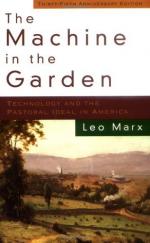|
This section contains 484 words (approx. 2 pages at 400 words per page) |

|
The Machine in the Garden; Technology and the Pastoral Ideal in America Summary & Study Guide Description
The Machine in the Garden; Technology and the Pastoral Ideal in America Summary & Study Guide includes comprehensive information and analysis to help you understand the book. This study guide contains the following sections:
This detailed literature summary also contains Topics for Discussion and a Free Quiz on The Machine in the Garden; Technology and the Pastoral Ideal in America by Leo Marx.
Author Leo Marx has aptly titled his work, The Machine in the Garden. Against the backdrop of a critical analysis of the works of dozens of eighteenth and nineteenth century authors, Marx poses his central theme of American technological progress and society's attempts to reconcile such progress with the initial pastoral ideal of America's founders. Marx identifies two types of "pastoralism," sentimental and complex. The sentimental variety is that expressed by the early settlers, who saw America as a lush paradise, a natural environment into which man could inject himself and live simply. Such sentimentalism bred the ideas of equality and the superiority of the "common man," pushing America toward independence from England and a democratic society which envisioned equality for all.
Enter the railroad and the steam engine. To Marx, these two inventions forever changed America, and catapulted her rapidly toward an industrialization that destroyed the original simple, agrarian lifestyle of her citizens. Railroads and steamboats became the symbols of progress, as track, roads, and rivers allowed travel throughout the nation, and the destruction of nature as well. Villages turned into towns; towns turned into industrialized cities; property lines were drawn, and man embarked upon a rapid path from cooperation with nature to control of nature, destroying it if necessary. The rapidity with which industrialism came to America, during the nineteenth century, left man with the realization that sentimental pastoralism was merely a dreamy illusion, and that Americans must find some method of reconciling this myth with reality. Thus, the concept of "complex pastoralism" was born, reflected primarily in the works of noted authors of the time.
Through an analysis of the works of Emerson, Thoreau, Melville, Hawthorne, Twain, Henry Adams, James, and Fitzgerald, author Marx demonstrates how literature not only reflected this conflict between technology and nature, but posed a variety of views on its resolution. Many believed that a reconciliation could occur, if Americans preserved the concept of the importance of maintaining a reverence for nature, using technology to improve their lifestyles but not to destroy their environment. Others believed that such a reconciliation would not be possible, and that man, in his attempts to progress and to control nature, would, in the end, destroy himself.
Marx leaves the reader a bit unsatisfied, as he proposes no lasting resolution to the conflict which he believes American society will continue to face. The sentimental idea of communing with nature is reduced to a "flight" to the suburbs, occasional excursions into what is left of the natural environment, and the continuation of our environment's destruction. In the end, he states, it is not up to the artists to pose the solutions. As well, traditional institutions will not resolve the issues we face. Americans must regain their sense of community and their sense of cooperation with nature by establishing new institutions, and that is the work of politicians and government.
Read more from the Study Guide
|
This section contains 484 words (approx. 2 pages at 400 words per page) |

|



